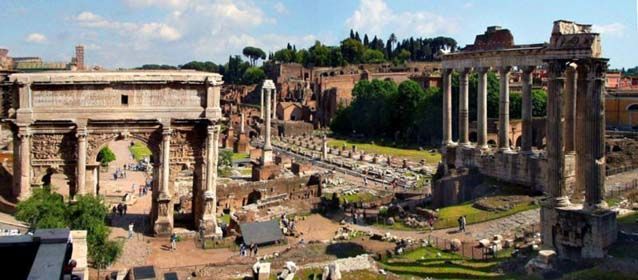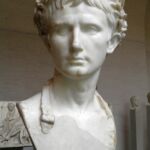Chapters
Forum Romanum literally means “Roman market”; also called Forum Magnum. It was the oldest square in Rome, at the foot of Capitoline Hill and Palatine Hill, which was the political and social centre of Rome during the republic. Its splendour was only overshadowed by the construction of the Forum of Augustus and the entire complex of imperial forums.
Roman kingdom
In the eighth century BCE, the area of the later forum was covered with swamps and only the drainage activities related to the construction of the drainage canal – Cloaca Maxima in the 7th century BCE caused the Romans to look more favourably at the obtained lands.
The first buildings were erected here during the reign of Tarquinius the Proud. During the reign of Tullus Hostilius, the forum was founded on Curia, originally called the Hostilius Curia, rebuilt and at the same time transferred by Julius Caesar. The first seeds of the Commission come from more or less the same period and were subjected to subsequent reconstructions. Even earlier, because during the reign of Numa, the Regia was established, however, more precise archaeological records date its creation only to the 5th century BCE.
One of the first historically certain structures is the Temple of Saturn (Aerarium Saturni or Aerarium Populi Romani). The building, erected on a high podium, occupied a rectangular area with an area of 20 by 40 m.
Roman republic
In 484 BCE erected the temple of the Dioscuri, which was created after the battle on Lake Regiluus in 496 BCE The rostrum also dates back to the beginnings of republican Rome – Rostra. From about 500 BCE instead comes the inscribed stele (Lapis Niger). According to sources, the tomb of the city’s founder, Romulus, was located in this place.
There is also a well on the forum, called Lacus Curtius. According to one of the sources, in 362 BCE Marcus Kurcjus was about to throw himself into the chasm which had suddenly formed in the middle of the Forum, after which the hole disappeared. A Temple of Concord (Concordia Ordinum) was also erected on the forum around this date.
From the 4th century BCE, there is also a prison (tulianum also known as the “Mamertine prison”). Initially, there was a water reservoir in this place, but soon it was used for “rehabilitation” purposes.
The next building was the Basilica of Aemilia (Basilica Aemilia) founded in 179 BCE on the initiative of consuls Marcus Aemilius Lepidus and Marcus Fulvius Nobilior.
For the period of the 2nd century BCE, the centre of the capital (Umblicus Romae) is also set up. In addition, the plate also specifies the distances between the main cities of the Empire.
In 121 BCE the first of the triumphal arches was erected on the forum. It was the Arch of Fabius erected by Quintus Fabius Allobrog after his victory over the Allobrogs. Unfortunately, it has not survived our times.
In 78 BCE a state archive (Tabularium) was built.
Roman empire
In 29 BCE the temple of the Divine Julius, dedicated to the memory of Julius Caesar, deified by the Senate, was consecrated. In the same year, the Arch of Augustus was put on the forum to celebrate the victory over Antony. In 20 BCE Octavian Augustus erected a gilded milaria (Milliarium Aureum), marking the beginning of all paths.
During the reign of Tiberius, another arch was erected – The Arch of Tiberius, to commemorate the retrieval of legionary marks by Germanicus lost in the Teutoburg Forest.
During the reign of Flavius, the temple of Vespasian was erected. In 85 CE there was also the Arch of Titus in the forum square.
In 141 CE Antoninus Pius built the temple of Faustina, dedicated to his recently deceased wife. After his death in 161 CE, the temple was renamed the temple of Antoninus and Faustina. After 30 years, after many centuries of reconstruction, the temple of Vesta got its present form. Next to the temple, there is the House of the Vestals (Atrium Vestae).
In 212 CE the arch of Septimius Severus was created to commemorate the victory of Septimius over the Parthians.
In 283 CE the fire almost completely consumed the Forum Romanum, as a result of which new buildings added splendour to the forum only in the 4th century CE. Diocletian restored the splendour of the place by building a monument of the tetrarchs near the Arch of Septimius Severus, which has not survived to our times, except for small figures of tetrarchs.
In the years 308 – 313 CE the Basilica of Maxentius was established. The initiator of the construction was also Maxentius, but the commissioning fell to Constantine, therefore, it is often also called the Basilica of Constantine. More or less the same period comes from the temple of Romulus, in memory of the deceased in 307 CE son of Maxentius.
The last structure erected on the Forum’s plan was the Phocas Column, erected in 608 CE by the Byzantine emperor Phocas.








